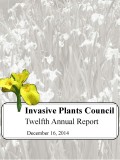The University of Connecticut Daily Campus featured an article on the continuing impact of invasive plant species in Connecticut.
Click on the link to view the online version of the article.
The University of Connecticut Daily Campus featured an article on the continuing impact of invasive plant species in Connecticut.
Click on the link to view the online version of the article.
CIPWG would like your help in tracking plants on our Early Detection and Research Lists throughout the growing season. Please visit http://cipwg.uconn.edu/early_detection/ for more information on these plants.
Plants on the Early Detection List are known to be invasive or potentially invasive in Connecticut and are on Connecticut’s list of Invasive and Potentially Invasive Plants. They are known to be present only in relatively low numbers at limited locations in Connecticut. These species should be considered for control and eradication efforts in the state when resources are available.
Plants on the Research List are plants about which more information is desired. This is not a regulatory list or an invasive plant list. Plants are not necessarily listed here prior to inclusion on an invasive plant list. Rather, more information about these plants and their occurrence in the state is desired.
We are particularly interested in new occurrences of plants listed on the Early Detection List. For help with identification of the plants on this list click below for slides:
Please report your findings to info@cipwg.org. Be sure to include as much detail as you are able (attach photographs if possible) and provide your contact information.
To view the updated map of Mile-a-minute vine (Persicaria perfoliata) distribution in CT click here.
Mile-a-minute vine is a highly invasive annual weed spreading across Connecticut. It outcompetes and overgrows native species, causing ecological and economic harm. The vine scrambles over other vegetation and can climb trees and posts. Mile-a-minute is deserving of its common name and its reputation as “the Kudzu of the North” – a single vine can grow up to 6 inches per day! Mile-a-minute has been banned by the CT Legislature (Sec. 22a-381d of the CT General Statutes makes it illegal to transport, sell, cultivate or distribute the species), but populations are still spreading in natural areas and perhaps in your own backyard!
Please help us find, track and control this plant in Connecticut. With your help, we can organize and coordinate the removal of Mile-a-minute vine before it becomes an even bigger and more costly problem. Identification and contact information can be found at www.mam.uconn.edu.
National Invasive Species Awareness Week is scheduled for February 22-28.
And according to experts with the Weed Science Society of America (WSSA), it’s a topic that deserves our attention. Non-native plants, animals and pathogens can harm humans and the environment and impact our nation’s economy. The damage done by invasive plants alone costs the U.S. an estimated $34.7 billion a year.
For more information on invasive species awareness events occurring across the nation this week visit www.nisaw.org.
 The 2014 Connecticut Invasive Plants Council Annual Report is available online. The 2014 Connecticut Invasive Plants Council Annual Report is available online.
A PDF version of the full report is available here. A shorter PDF version containing only the Chairperson’s letter and a summary of activities/accomplishments is available by clicking here. Visit www.cipwg.uconn.edu/ipc/ for more information about the Invasive Plants Council. |
The Connecticut Invasive Plant List was most recently revised in November 2014. The list includes Invasive and Potentially Invasive Plants as determined by the Connecticut Invasive Plants Council in accordance with Connecticut General Statues 22a-381a through 22a-381d. Click on the following text to view the 2014 Revised CT Invasive Plant List sorted by scientific name (PDF).